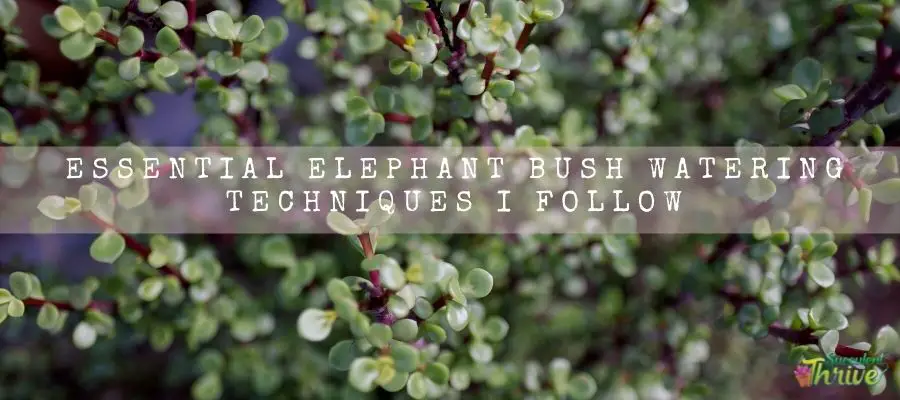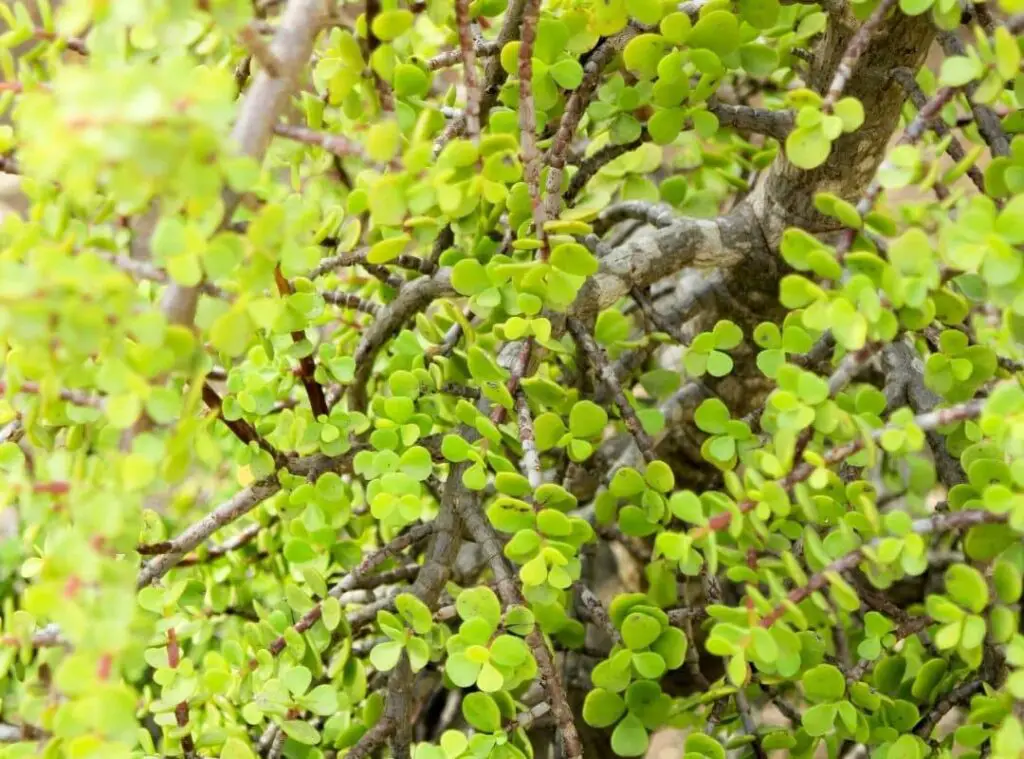If you are wondering whether your elephant bush watering techniques are correct or not, you could simply observe the plants’ outlook and decide whether they need it.
There are certain ways in which you could decide on this, and we are going to cover this from this article.

How to tell when Elephant bush needs water
To start off and to briefly explain on the plants, they are endemic to South Africa. Some of the common names you could call these plants are elephant food, dwarf jade .
Usually if your plants are running short of sufficient water, you will see how they form limp and dull leaves.
However, you should not be worried about it and all you need to do is to water them immediately whilst using the soak and dry method.
If you spot the aforesaid indications in the outdoor grown plants, you need to start watering them whilst applying the same steps.
On the other hand, if you had supplied these plants with excess water, you would see how they form a mushy stem.
Further they would turn their leaves yellow and transparent too. If you come across such a situation, you need to minimize watering them so that it will allow the plants to revive.
Over-watering could create worse repercussions than what it does from underwatering.
Watering the elephant bush plants is very easy. They are more tolerant of both under watering and over watering than the other many succulents also.
Elephant bush watering frequency
You need to water the elephant bush plants more often in spring and fall than in summer simply because they are actively growing in spring and fall.
If you spot their soil is dry, you could start watering them. Further when watering them, ensure that the excess moisture is moving through the draining hole.
In terms of the frequency of watering them in spring and fall, you may do it once every few days whenever you spot their soil is bone dry.
How long it can go without water
Elephant bush plants can grow waterless for a longer period since they are used to growing in the drought conditions when they grow in their natural habitats.
Hence, you may skip watering them for a few weeks and they will still grow well.
Watering Elephant bush without drainage
If you have grown them in a planter which does not have any draining holes, watering them adequately and properly is quite crucial when looking after the plants well.
When you grow them in planters which have draining holes, that will ensure that no excess moisture is retained in the pot.
I would suggest you water the plants with a water amount which is equal to the 50 % of the soil amount and its container.
Further you should do this only if their soil is bone dry only. On the other hand, you may simply bring the planter or the container and check its weight.
If you feel like the container is light , you could water them. You would need some expertise to apply this method when watering them, but when you get used to this method you will learn how to water them properly by using this method.
Elephant bush watering amount
Elephant bush plants require a good drink of water generally once every few days.
However if the plants are going through a heat wave, you need to be extra cautious and enhance watering them more.
On the other hand if there are high humidity levels around the plants, You should minimize watering them and do it less often, like once every fortnight.
Elephant bush water from top or bottom
Best is to water them right in the soil so that the roots can absorb the water as they wish.

Elephant bush watering in winter
Elephant bush plants actively grow in spring and fall and in winter. During these seasons, they will require more water than summer. That will help them to grow vigorously.
Elephant bush watering in summer
Elephant bush plants go into dormancy during summer, you could spot them mainly among the plants which you have grown outdoors.
During their dormancy you need to ideally reduce watering them and do it less often. They will be literally in their relaxing mode during summer, and they do not consume any energy during summer.
If you supply them with excess water during summer, it will make the plants vulnerable to root rot.
Indoor Elephant bush watering
Literally, indoor grown elephant bush plants need less amount of water compared to the outdoor grown plants.
That is simply because indoor grown Elephant bush plants water evaporation rate is less than the outdoor grown Elephant bush plants.
Further the airflow in the outdoors is higher and hence you need to water the outdoor grown plants more.
It is hard to spot the indoor grown elephant bush plants that go dormant during summer as they will get moderate weather conditions right throughout the year.
Hence, you could water them as they are in their actively growing season right throughout when it comes to the context of watering.
When it comes to watering the indoor grown elephant bush plants, you need to grow them in containers which have sufficient draining holes.
It is a crucial factor since watering them properly and growing them in a pot which has sufficient draining holes go hand in hand when taking care of them well.
You need to keep in mind that you should water them deeply and do it less often. Always ascertain that there is no excess water retained in the pot and that it has all drained from the draining holes.
You should ensure that they get the same growing requirements as what they get in the wild when you look after them well.
Hence watering should also be done in such a manner where they do not get excessive amounts of water at any given time.
These plants have water conserved in the body and thus, they want to go through some drought periods where they can use their conserved water in the body.
Further make sure that you water the plants in a manner where the water can reach all the sides of the container evenly. In case if you end up watering just one spot in the pot too much, it will make the plants rot.
Outdoor Elephant bush watering
Elephant bush plants which are grown outdoors will go dormant in summer. Hence , you could hardly water them during summer.
However, if you spot any of them forming limp and dull leaves only, you should start watering them. Avoid applying the soak and dry method when watering them during summer like you do in fall and spring.
When they are actively growing, you may water them when their soil is bone dry only
. If you are unsure whether the soil is dry or not, you may simply place a stick in the soil and check the soil condition.
If you notice that the stick is coming out dry, it is time for you to start watering them. if the soil is soggy, you may wait for some more days and water them.
Small Elephant bush watering
Elephant bush plants used to grow in drought conditions. Make sure that they are moist in condition and not soggy or even bone dry.
Ensure that you have grown the small Elephant bush plants in a small planter which is well draining. Further refrain from leaving a saucer with water under the planters as well.
Should you water newly brought Elephant bush
If you spot the newly bought elephant bush plants that are bone dry, you should go ahead with watering them. As aforesaid, do not leave them in waterlogged conditions at any given time.
Should you water newly repotted Elephant bush
Do not water these plants right after you repot them. Instead, wait for a few days and allow them to adjust to the new growing conditions and then water.
However, do not forget to water them before you repot them. That will allow them to absorb the necessary water levels they want .
Best would be to wait for about one week’s time from repotting and then water them.
What you need to water an Elephant bush
- Watering can
- Water measuring cup
- water squeeze bottle
Do Elephant bushes need more water than cacti?
In the general context, both the cactus and elephant bush plants have the same requirements when it comes to watering them.
Once a week watering them would be enough for both these plants when they are in their actively growing phase.
Do not soak them with water and ensure that soil is dry between two watering sessions for both cactus and elephant bush succulents.
Does Elephant bush like humidity?
They will prefer to have moderate humidity levels to grow well.
Do not leave them closer to air conditioners or near to heating vents as they do not prefer to grow in low humidity levels.
What type of water should you use to water them?
Consider watering them with rainwater as it would be perfect for them. Ideally you could collect water in fall and then use it right throughout the year.
Alternatively, you may use distilled water or purified water also if you can’t use rainwater for this purpose.
I encourage you to not to use tap water as it contains chemicals which would result in mineral build ups in the soil.
Ultimately it will avoid the roots absorbing the nutrients in the soil mix. However,if you do not have any other option except using tap water, you may treat it first and then apply it.
To treat them, you could simply let the water be in an open container for a couple of days and then use it. That will allow the chemicals to evaporate into the air.
Conclusion
To sum up, keep in mind that you should stick to the soak and dry method when watering the indoor grown elephant bush plants
Further when watering the outdoor grown plants, you could apply the same method in spring and fall.
Finally, during summer you could water them only if you spot any signs of under watering.
Read Next : Elephant Bush Flower | The Forgotten Facts | Why Are Elephant Bush Leaves Falling Off? (Problem Solved) Elephant Bush Succulent | Why Is Everyone Talking About Them |
